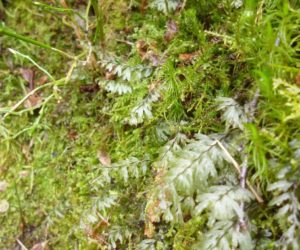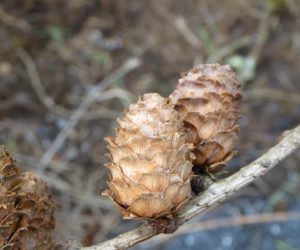Kirkcudbrightshire Botany Group at Glentrool, 29/03/2018
The first visit of the season, hoping for Wilson’s Filmy Fern Hymenophyllum wilsonii before the explosion of vegetation made it difficult to find this tiny fern. To aid us, the weather has been un-spring like for weeks now and is about a fortnight later than usual; the downside was the threatened rain and cold winds. Despite this, 6 of us were prepared to brave it and it turned out to be better than forecast.

From the Glen Trool – Bruce’s Stone car park, we walked the 400m to Buchan Bridge and the steep-sided, deep ravine where the fern was last encountered, recording whatever plants along the way that we could identify. Despite some considerable time and precarious scrambling over wet mossy rocks around the bridge, we drew a blank on the fern. Disappointed by this failure we walked a further 1km to the Gairland Burn which is a shallow rocky and gently sloping burn, to try our luck there. Again none. However on our return, we tried Buchan again and one of the group eventually discovered the fern in some quantity on a moss-covered rock face well above the water level and some 100m upstream from the bridge. While this was being examined, discussed and photographed, another group member had with the aid of binoculars discovered many more fronds covering a fallen oak spanning the gorge.
It was only after this discovery that yet another member of the group revealed that he had been out the previous day in Dumfriesshire with Chris Miles to the site of Tunbridge Filmy Fern H. tunbrigense which doesn’t occur in Kirkcudbrightshire and seen that. So for one of our members, both filmy ferns in 2 days!
These apart, we recorded anything we could identify, even at the early stages of growth or from dead stems and flower/seed heads. The area around Buchan Bridge had been fully, so the previous surveyors then thought, surveyed in 2002, but we added another couple of species – the tiny creeping stems of Blinks Montia fontana and a clump of flowering daffodils Narcissus agg. Little else was in flower, but Barren Strawberry Potentilla sterilis was just about to open its buds, with white petals just beginning to show; Hazel Corylus avellana had both male and female flowers open or opening; Daisies Bellis perennis; and a solitary Primrose Primula vulgaris beginning to show yellow buds opening. All else was identified by first leaves.

After the walk back to Buchan Bridge and the filmy fern, we sat over lunch at Bruce’s Stone, but the cold wind soon had us moving again. We drove back to Stroan Bridge, stopping there to get tea/coffee, before searching the area for plants. No filmy fern, but this was not unexpected. Walking upstream involved discussions about Irish ivy and the ordinary ivy and how to distinguish them – the two have only been separated recently. We also discussed the various larches Larix spp. and how to distinguish the two species and the hybrid – size of cone and the degree of curling of the scales.
This one is likened to a woody rose, with the scales curled outwards and downwards and the ovoid cone taller than wide.
At Stroan Bridge, we found a few plants in the recently re-sown adjoining ground which we couldn’t identify – a couple of grasses and a rosette of glossy, dark green, three-lobed leaves of a buttercup-like plant. Could be a buttercup Ranunculus sp., possibly Celery-leaved Buttercup R. sceleratus, or Globeflower Trollius europaea or even something else. Have to go back later in the season to find out. Then we found a rock outcrop just below the bridge which showed signs of mineral enrichment with a single strand of Thyme Thymus praecox, abundant Goldenrod Solidago virgaurea and Devil’s-bit Scabious Succisa pratensis; Slender St John’s Wort Hypericum pulchrum; a mouse-ear which I was later able to identify as the orange flowering Fox and Cubs Pilosella aurantiaca. A real surprise was to find a small cluster of rosettes of tiny glaucous, silver-edged leaves – a distinct sign of Mountain Everlasting Antennaria dioica.
Time ran out and we didn’t get to Newton Stewart to look for more filmy ferns. The day eventually produced 164 records of 75 species from three monads, but more would undoubtedly be evident later in the year.
